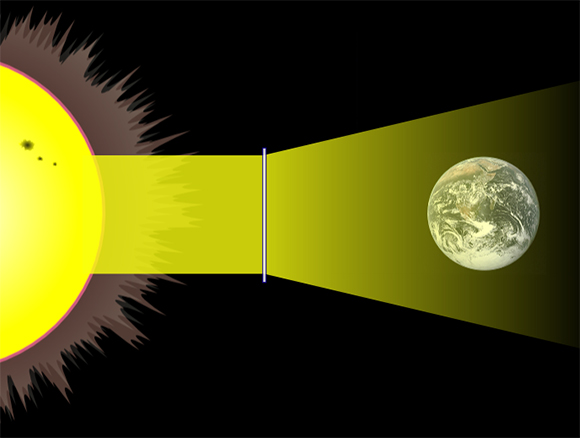Atmospher Sci & Global Chg
Research Highlights
September 2013
Computer Simulations Show Effects of Engineering the Climate
Idealized geoengineering techniques evaluated for impact on global warming

One proposed method of solar geoengineering involves a lens in space to reduce the amount of sunlight that reaches Earth’s surface. This simplified image shows one concept of solar reduction to cool the planet. Image courtesy of Wikimedia Commons. Enlarge Image.
Results: A large international research team from centers around the world, led by Pacific Northwest National Laboratory, for the first time used 12 climate models to show basic climate responses to geoengineering—theoretical techniques to purposefully alter the climate. As simulated, all models showed that uniform solar geoengineering cannot simultaneously return regional and global temperature and water cycle changes to preindustrial levels. This is the first paper resulting from the highly anticipated Geoengineering Model Intercomparison Project (GeoMIP) using the full suite of models.
Why It Matters: The concept of engineering the climate may seem a bit like science fiction to some. However, forestalling or reversing the warming effects of greenhouse gases in the atmosphere is a serious prospect. Geoengineering has been proposed as a means of offsetting some amount of global warming if steps to reduce greenhouse gas emissions are not implemented rapidly enough. To investigate the effectiveness of these proposed techniques, most past studies were conducted with single-model simulations. By using multiple models, scientists in this study reduced the dependence of the results on any one model. Even if geoengineering is never conducted in the future, their simulations are useful for gaining insight into the intricate, complicated processes that control the climate system.
Methods: The research team performed a computational study using 12 state-of-the-art models from climate modeling centers around the world. They conducted the same experiment in each model, comparing preindustrial climate conditions to a future climate with solar geoengineering techniques applied.
The team's study found small, annual mean precipitation-minus-evaporation changes, although some tropical regions received less precipitation than under preindustrial conditions. Net primary productivity, an indicator of plant growth, increased by 120 percent, mostly due to more available CO2. The researchers found that solar reduction methods could be effective at returning globally averaged temperatures to preindustrial levels and prevent 97 percent of the Arctic sea ice loss that would otherwise occur under high CO2 levels. However, compared to the preindustrial climate, tropical regions would still be cooler, and polar regions warmer.
What's Next? This paper is the first publication in a special issue of the Journal of Geophysical Research-Atmospheres containing results from the GeoMIP. Future research aims to increase understanding about the expected climate effects of geoengineering while providing new insight into how the climate system behaves.
Acknowledgments
Sponsors: The PNNL team was supported by the Fund for Innovative Climate and Energy Research (FICER). The U.S. Department of Energy's Program for Climate Model Diagnosis and Intercomparison (PCMDI) provided coordinating support for the Coupled Model Intercomparison Project (CMIP) and led development of software infrastructure in partnership with the Global Organization for Earth System Science Portals. For a complete list of team member funding support, refer to the acknowledgements in the paper.
Research Team: Ben Kravitz, Philip J. Rasch, Balwinder Singh and Jin-Ho Yoon, PNNL; Ken Caldeira, Carnegie Institution for Science, Stanford; Olivier Boucher, Laboratoire de Météorologie Dynamique, Paris; Alan Robock, Rutgers University; Kari Alterskjær and Jón Egill Kristjánsson, University of Oslo, Norway; Diana Bou Karam, Laboratoire des Sciences du Climat et de l'Environnement, France; Jason N. S. Cole, Environment Canada; Charles L. Curry, University of Victoria, Canada; James M. Haywood, University of Exeter, and Andy Jones, Met Office Hadley Centre, Exeter, UK; Peter J. Irvine, Institute for Advanced Sustainability Studies, Potsdam, Germany; Duoying Ji and John C. Moore, Beijing Normal University, China; Daniel J. Lunt, University of Bristol, UK; Ulrike Niemeier and Hauke Schmidt, Max Planck Institute for Meteorology, Hamburg, Germany; Michael Schulz, Norwegian Meteorological Institute, Oslo; Simone Tilmes, National Center for Atmospheric Research; Shingo Watanabe, Japan Agency for Marine-Earth Science and Technology; and Shuting Yang, Danish Meteorological Institute, Copenhagen.
Reference: Kravitz B, K Caldeira, O Boucher, A Robock, PJ Rasch, K Alterskjær, DB Karam, JNS Cole, CL Curry, JM Haywood, PJ Irvine, D Ji, A Jones, JE Kristjánsson, DJ Lunt, JC Moore, U Niemeier, H Schmidt, M Schulz, B Singh, S Tilmes, S Watanabe, S Yang, and J-H Yoon. 2013. "Climate Model Response from the Geoengineering Model Intercomparison Project (GeoMIP)." Journal of Geophysical Research: Atmospheres 118(5):8320-8332. DOI: 10.1002/jgrd.50646.
